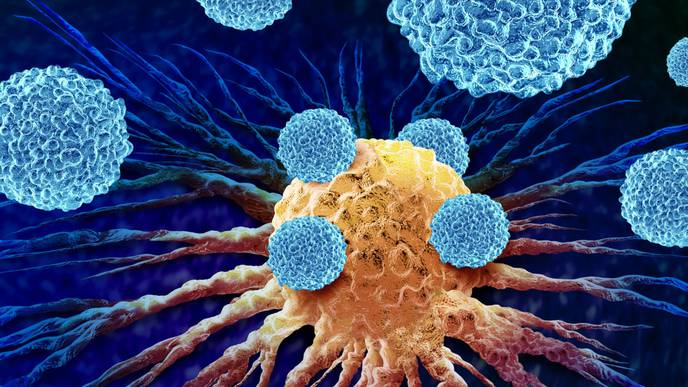Research Raises Hopes for New Treatment of Fusion-Driven Cancer

08/16/2023
A new study presents a promising treatment method for so-called fusion-driven cancers, which are currently often difficult to cure. These fusion-driven cancers are caused by an error in cell division that creates a fusion of different genes. This fusion causes the cancer and drives the uncontrolled cell growth.
Using the so-called molecular scissors CRISPR/Cas9, researchers from Aarhus University have developed a gene therapy that can stop cell division in a subtype of the aggressive blood cancer acute myeloid leukemia (AML).
The study has just been published in the scientific journal Leukemia. Even though the study focuses on blood cancer, many other types of cancer are also driven by fusion genes, for example some lung cancers and sarcomas. The researchers hypothesize that this technology can become a platform technology for specific types of cancer driven by fusion genes.
A paradigm shift in cancer therapy
So far, this gene therapy has been carried out in the laboratory on cell lines and mice. But the results are an important step towards developing a new form of treatment based on targeting the drivers of the disease, explains Associate Professor Maja Ludvigsen from the Department of Clinical Medicine at Aarhus University, who is one of the authors behind the study.
In brief, the researchers have succeeded in cutting genes that, in fusion cancers, are fused incorrectly together and which send a fatal signal to cells to begin dividing uncontrollably. When the fusion gene have been cut, the cancer cells stop dividing.
In this study, the researchers have applied this treatment to cells in a laboratory setting by opening the cell membrane using electricity, a recognized laboratory method that allows substances to pass through the cell membrane. In this way, the 'scissors'—the enzyme Cas9—can target the gene together with guides that consist of RNA (guideRNAs).
"You can use this method in the laboratory, but not in patients. We need to investigate how we can get both scissors and guideRNAs into the cancer cells," says Maja Ludvigsen, who adds that the authors are already working on using fat particles as a delivery method in a parallel study. This method worked very well as a delivery strategy with the mRNA vaccine against COVID 19.
So far, the researchers have inserted cell lines with cancer in the flanks of mice. The non-treated cell lines grew into large tumors, while the treated cells, that had been exposed to the gene therapy before being inserted into the mice, resulted in much smaller tumors or none at all.
"Our gene therapy seems to be extremely effective in the laboratory. We don't know whether we can make the therapy effective enough to target all the cancer cells. But there is a hypothesis within the field of cancer research that, if you can target the majority of the cancer cells with a treatment, the immune system will take care of the rest," says Maja Ludvigsen.
The next task will be to demonstrate that the treatment with the most optimal delivery method also works in mice that have the specific fusion-driven subtype of leukemia.
The researchers are also aiming to examine whether this treatment strategy could be a new and better treatment option for other fusion-driven cancers. But there is still some way to go. For example, the researchers do not yet know about the potential side effects of this gene therapy.
"One of the challenges is that if we cut the DNA in a cancer cell where the chromosome is placed incorrectly, then we'll also be cutting the same chromosome in other healthy cells. Since the fusion gene is not present in healthy cells, our theory is that healthy cells can repair their DNA themselves, but naturally we have to look into this more closely," explains Maja Ludvigsen.
Hope for a more effective treatment
The results created in collaboration between researchers from the Department of Clinical Medicine and the Department of Biomedicine at Aarhus University represent an important step towards understanding and treating fusion-driven cancers.
"This is still in the stage of translational research, but it's a breakthrough because we've succeeded in using the CRISPR/Cas9 technology as target treatment for the specific fusion gene that drives the cancer," says Maja Ludvigsen, who hopes clinical trials with this form of treatment can begin within five years.
"Even though there's still a lot of work to be done, the results give hope for an effective treatment for patients who have had limited opportunities until now. I hope that, in the future, we'll be able to introduce a more gentle and more effective treatment without serious side effects," says Maja Ludvigsen.
Facts: What is fusion cancer?
- Cancer occurs when cells begin to divide uncontrollably somewhere in the body. One of the reasons for this is the so-called fusion genes.
- In fusion cancer, genes fuse together incorrectly during cell division. Moreover, the fusion genes signal to the cells to divide uncontrolled and intensively, thereby driving the disease.
- In lung cancer, leukemia and sarcomas in soft tissues are all examples of cancers with fusion-driven subtypes.
- There are also other types of cancer that are not caused by fusiongenes, but rather by other genetic abnormalities, including gene mutations.
More information: Signe Neldeborg et al, Dual intron-targeted CRISPR-Cas9-mediated disruption of the AML RUNX1-RUNX1T1 fusion gene effectively inhibits proliferation and decreases tumor volume in vitro and in vivo, Leukemia (2023). DOI: 10.1038/s41375-023-01950-9
Citation: Research raises hopes for new treatment of fusion-driven cancer (2023, August 11) retrieved 11 August 2023 from https://medicalxpress.com/news/2023-08-treatment-fusion-driven-cancer.html
This document is subject to copyright. Apart from any fair dealing for the purpose of private study or research, no part may be reproduced without the written permission. The content is provided for information purposes only.

Facebook Comments